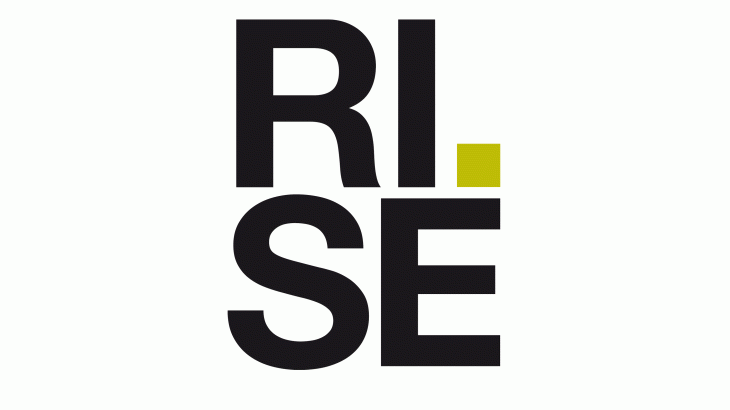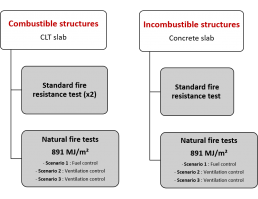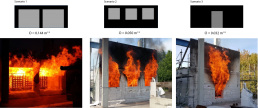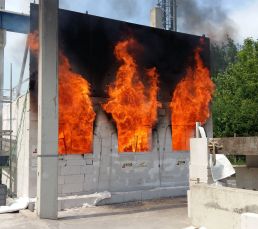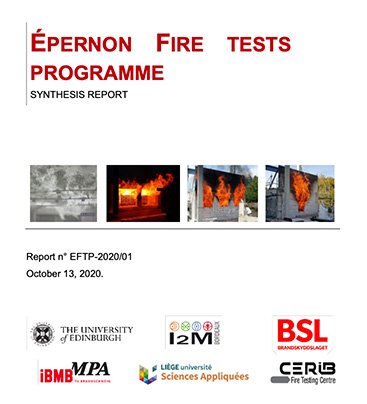In Phase 1, the experimental campaign included fire testing of two different loaded structures, ceiling slabs made of cross-laminated timber (CLT) and ceiling slabs made of reinforced concrete. These two types of slabs were tested both in standard fire resistance (i.e. furnace) tests, and in compartment fire experiments with timber cribs as a fuel load. Three opening factors were tested. The campaign was conducted at the CERIB testing facility in Épernon, France.
Fire resistance
The three performed furnace fire tests led to a fire resistance rating REI 120 for both the CLT and the concrete slabs. The criteria that was broken and gave the fire resistance time in all cases was the deflection rate. In the concrete element test the collapse occurred at the same time as the breaking of the deflection rate criteria (Table 1).
During the furnace tests, the test on concrete was shown to have consumed nearly three times more natural gas than did the tests performed on CLT slabs, even though the thermal exposure was identical for the three standard tests.
Table 1. Results from standardized fire resistance tests in the furnace.
| Broken criteria | Concrete | CLT (test 1) | CLT (test 2) |
| Limiting deflection | 125 minutes | 141 minutes | 131 minutes |
| Limiting deflection rate | 125 minutes | 125 minutes | 121 minutes |
During the compartment fire tests, the CLT slab in scenario 3 collapsed after 108 minutes of exposure, being earlier than the determined fire resistance in the furnace tests. Further on, the CLT slab in scenario 2 collapsed 29 hours after the start of the fire test. No collapse was observed for the other tested elements.
MORE INFORMATION
The test reports, the excel sheets and a summary report of the project including further analysis can be downloaded from the table below. A number of peer reviewed publications with further analysis from the project are listed below.
The outcomes of the project shed light on several issues which should be considered when assessing a building using a fire safety engineering approach to provide an adequate level of safety.
Synthesis Report
Test Reports
| Test Report | Data sheets | Tested element | Type of fire |
| Loadbearing CLT slab | Standard fire (EN 1365-2) | ||
| Loadbearing concrete slab | |||
| Loadbearing concrete slab | Natural fire (Scenario 1) | ||
| Loadbearing CLT slab | |||
| Loadbearing CLT slab | Standard fire (EN 1365-2) | ||
| Loadbearing concrete slab | Natural fire (Scenario 2) | ||
| Loadbearing CLT slab | |||
| Loadbearing CLT slab | Natural fire (Scenario 3) | ||
| Loadbearing concrete slab |
Publications
- “Comparative Energy Analysis of Fire Resistance Tests on Combustible versus Non-Combustible Slabs”
Alastair I. Bartlett, Robert McNamee, Fabienne Robert, and Luke Bisby, Fire and Materials, 2019
https://onlinelibrary.wiley.com/doi/abs/10.1002/fam.2760 - “Structural Capacity of One-Way Spanning Large-Scale Cross-Laminated Timber Slabs in Standard and Natural Fires”
Felix Wiesner, Alastair Bartlett, Siyimane Mohaine, Fabienne Robert, Robert McNamee, Jean-Christophe Mindeguia & Luke Bisby, Fire Technology, 2020.
https://link.springer.com/article/10.1007/s10694-020-01003-y - “Enclosure fire dynamics with a combustible ceiling”
Robert McNamee, Jochen Zehfuss, Alastair I. Bartlett, Mohammad Heidari, Fabienne Robert and Luke Bisby, Fire and Materials, 2020
https://onlinelibrary.wiley.com/doi/full/10.1002/fam.2904?af=R - “Thermo-mechanical behaviour of cross-laminated timber slabs under standard and natural fires”
Jean-Christophe Mindeguia, Siyimane Mohaine, Luke Bisby, Fabienne Robert, Robert McNamee, Alastair Bartlett, Fire and Materials. 2020; 1–19
https://onlinelibrary.wiley.com/doi/abs/10.1002/fam.2938?af=R - “Heat fluxes to a façade resulting from compartment fires with combustible and non-combustible ceilings”
Alastair Bartlett, Angus Law, Robert Jansson McNamee, Jochen Zehfuss, Siyimane Mohaine, Christophe Tessier, Luke Bisby, 3rd international symposium for Fire Safety of Façades, 25-27 September 2019, Paris - “Thermal and mechanical response of reinforced concrete slabs under natural and standard fires”
Siyimane Mohaine, Nataša Kalaba, Jean-Marc Franssen, Luke Bisby, Alastair Bartlett, Jean-Christophe Mindeguia, Robert McNamee, Jochen Zehfuss & Fabienne Robert, 6th International Workshop on Concrete Spalling due to Fire Exposure, 19-20 September 2019, Sheffield
https://firespallingworkshop2019.group.shef.ac.uk/wp-content/uploads/2019/09/Fire-Spalling-Workshop_Proceedings.pdf





